
Are you an artist that struggles with distractions? Here’s your chance to apply for a residency on a deserted tropical island: The National Parks Arts Foundation is partnering with Dry Tortugas National Park to host two artists on Loggerhead Key, located 70 miles west of Key West, Florida.
The perks include beautiful sandy beaches, clear turquoise water, and historic sites including 16th century pirate hideouts and a powerful 19th century fort constructed to protect the US coastline.
Dry Tortugas Light on Loggerhead Key. Photo: NPAF.
However, the National Parks Arts Foundation warns, “Due to the intense, isolated nature of this residency, we are accepting only joint applications; either artist couples or two artists who are willing to tolerate each other for the duration.”
Additionally the organizers stipulate that “The artist(s) bears the full cost of travel to and from Loggerhead Key, Dry Tortugas National Park… and must make arrangements and preparations to feed themselves while there.” The website emphasizes “This is a VERY isolated location!”
In other words, participants must be prepared to live completely off the grid. The location is only accessible by boat or seaplane and there is no access to internet, phones, or television.
Dry Tortugas National Park. Photo: Wikimedia Commons.
Furthermore, according to the residency’s FAQ section, “There is no studio available.” Organizers stipulate that “you must be a ‘plein-air’ artist or one whose artistic media does not require a studio.”
Surprisingly, or maybe not, the FAQ section also admits that the application process “Is NOT competitive at all,” adding “in fact, you could literally be the first one to apply.”
The first Europeans to discover the Dry Tortugas islands were Spanish explorers led by Juan Ponce de León. The islands were a hotbed for pirates during the so-called “golden age” of Caribbean piracy. Later, in the 20th century, the Carnegie Institute operated a Marine Biology Laboratory at Loggerhead Key from the early 20th century until 1939.